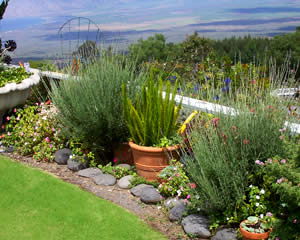CTAHR Cooperative Extension Service
Home and Garden
 CTAHR has active Master Gardeners (MG) Programs in Pearl City, Lihue, Kahului, Kona
and Hilo. The Pearl City Urban Garden Center is our flagship facility for home and
urban gardening and is also home to our first and largest MG Program in Hawai‘i.
The MG programs provide support to the College by helping with open houses, fairs,
gardening demonstrations, answering questions telephoned in through the Home Gardening
Helpline, and in many other ways. Web-based information for maintaining and improving
homes are also available through this section.
CTAHR has active Master Gardeners (MG) Programs in Pearl City, Lihue, Kahului, Kona
and Hilo. The Pearl City Urban Garden Center is our flagship facility for home and
urban gardening and is also home to our first and largest MG Program in Hawai‘i.
The MG programs provide support to the College by helping with open houses, fairs,
gardening demonstrations, answering questions telephoned in through the Home Gardening
Helpline, and in many other ways. Web-based information for maintaining and improving
homes are also available through this section.Ask an Expert
Expert advice and information on frequently asked questions on a variety of subjects.
Coffee Berry Borer
Coffee Berry Borer (CBB) is a serious, worldwide pest of coffee. The beetle lives within and feeds on the coffee bean, and on the pulp surrounding the bean (the cherry). CBB was first found in Hawai‘i south of Kailua-Kona in late 2010.
Hawai‘i Backyard Conservation handbook
A popular handbook written to assist homeowners to conserve and improve natural resources in your backyard. This was a joint effort by several agencies the USDA Natural Resources Conservation Service, Hawai‘i Department of Land and Natural Resources, CTAHR, Hawai‘i Department of Transportation, and the Honolulu Board of Water Supply and others.
Hawai‘i Termite Project
All you wanted to know about termites in Hawai‘i with a focus on termite research in CTAHR.
Human Issues in Horticulture
Plants and people have an intimate connection that evolves around sustainable, environmental, and social-psychological parameters. Plants provide us with food, shelter, and aesthetically pleasing environments. An example of some of these environmental benefits are: replenishing O2 supply, preventing soil erosion, cooling buildings and neighborhoods, filtering dust and buffering noise to mention a few. Beyond this are social and aesthetic qualities and benefits that plants provide people such as, improving property value, providing a sense of community, fostering sense of well- being, providing aesthetically pleasing environments, and improving social, psychological, and physical health of people. Beyond these benefits are the physical, emotional, and preferences and responses that people have with plants. Investigating and documenting these responses is at the heart of what People-Plant Interaction/ Human Issues in Horticulture is about in order to understand and communicate the importance of plants in society.
Feasibility Study of Green Roof Technologies in Urban Districts in Hawai‘i
In response to concern about increasing urbanization, the Hawai‘i State Legislature asked CTAHR to conduct a feasibility study on rooftop landscaping and agriculture in urban district subcategories such as commercial, hotel, multi-family, industrial, or mixed used with a commercial component. This report provides some basic facts about green roofs, and quantitative and qualitative information about various benefits and costs of green roofs in order to gauge feasibility. Also included are discussion on policies to encourage installation of green roofs to residents and businesses, results of an opinion poll of residents and visitors about green roofs, and overall conclusions and recommendations.
Master Gardener’s program Urban Garden Centers
Turfgrass Management
Turf and green industry contributes significantly to Hawai‘i’s economy. Due to biology, ecology, intensive management and disturbances, turf system oftentimes has different and specific pest management issues compared to traditional agricultural systems. In addition, the year-round growing conditions in Hawai‘i are not only good for turfgrass, but also for a diverse range of turf pests. These unique turf management challenges in Hawai‘i call for effective management strategies based on applied research. The overall goal of the turf management program is to provide effective turf pest management options to diverse stakeholders in Hawai‘i, and on a broader sense, turf and green industry in tropical regions of the world, through extension education and outreach activities built on applied research.
If you require information in an alternative format, please contact us at: ADA-contact@ctahr.hawaii.edu
